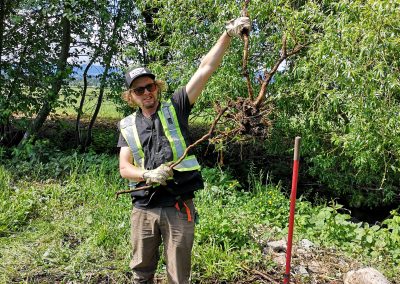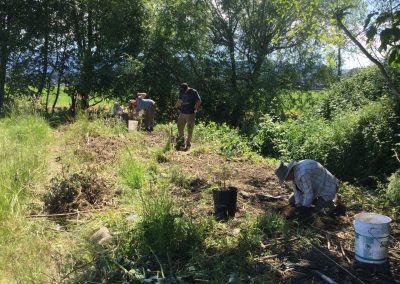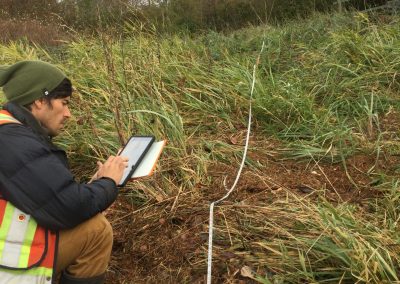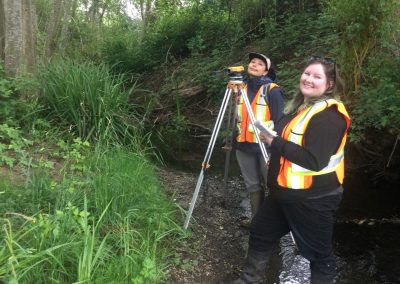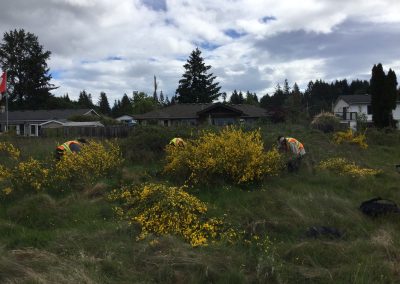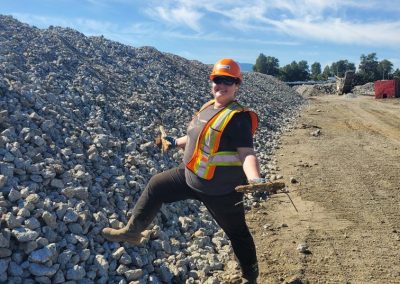Technician Report – Tuesday, December 14th
Aaron, Sam, and Zoe Removing Blackberry ~ By J. Lund
Our team removed invasive plant species from vulnerable ecosystems all season long. Scotch broom (Cytisus scoparius), Himalayan blackberry (Rubus armeniacus), Himalayan balsam (Impatiens glandulifera), bittersweet nightshade (Solanum dulcamara), and reed canary grass (Phalaris arundinacea) were the main plants targeted for removal. At Glen Urquhart stream, over 100 metres of stream bank was cleared of invasives after being surveyed. This area was then planted with native shrubs and trees such as thimbleberry (Rubus parviflorus) and red elderberry (Sambucus racemosa).
In the height of the growing season, our team surveyed six transects throughout Hollyhock Flats to create a plant species catalogue. This data will be used to track how the Hollyhock marsh changes over time, be used for modelling salt marsh restoration projects, and provide a planting guide for Kus-kus-sum. Our team surveyed 1.18 kilometres of the marsh with 234 quadrats.
At Kus-kus-sum, we were able to assist with several projects. Before concrete removal began, we cut down all the Scotch broom plants on site. This was done while they were in bloom to decrease seeds in the soil and reduce the chance of broom plant growth in the future. While concrete removal was on going, we were sorting out metal and wood for recycling. We also helped with the removal of crush from the site and installation of sediment fencing to reduce erosion.
As the seasonal Technician team winds down and heads off on new adventures, we would like to thank you for following our work with Project Watershed. We wish you all a wonderful holiday and a happy new year!
With the help of the Healthy Watersheds Initiative funding Project Watershed has hired environmental technicians to assist with our projects over the summer and early fall. The Healthy Watersheds Initiative is delivered by the Real Estate Foundation of BC and Watersheds BC, with financial support from the Province of British Columbia as part of its $10-billion COVID-19 response. Jamie Lund, one of these technicians, will be posting a brief report every Tuesday to update the Project Watershed community on what they have been up to.
Related Posts
Kus-kus-sum: End of Season Wrap-up
Now that we have put the Kus-kus-sum site to bed for the winter, we wanted to give you all a little update on how things progressed this season – lots happened!
Kate McKeown
Meet our new Forage Fish Technician!
Greenshores at Dyke Road Park – Reimagining a Park
On September 20 and 21, over 20 people were on site to help with planting at the Comox Valley Regional District’s (CVRD) Dyke Road Park redevelopment project.
Gartley Beach Green Shores for Homes Project
Project Watershed is teaming up with the CVRD and the Stewardship Centre for BC to do some shoreline restoration at Gartley Beach in Royston.
Fall and Winter Forage Fish Sampling
We’re gearing up for the fall/winter season of forage fish sampling!
Mallard Creek Riparian Planting
We will be planting native riparian species along a section of Mallard Creek that we recently cleared of invasive Reed canarygrass.



